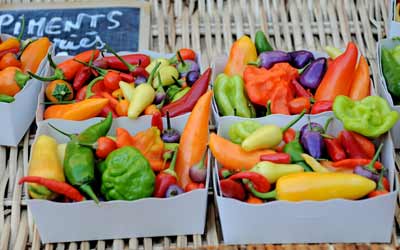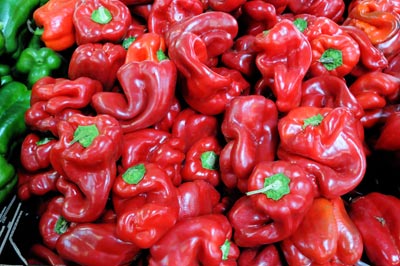
Red pepper (US: sweet red bell pepper). The large varieties are used as a vegetable and can be used either cooked or raw. Other varieties are smaller, long, with a pointed tip and filled with pungent seeds. They are used for seasoning, either dried or fresh. These peppers are not so strong in flavour as the chilli or cayenne pepper. In fact, in French, piment also means chillis, which are green or red, tapered and contain twice as much capsaicin as red peppers, which is why they provide so much heat to food. They are often available in dried or powdered forms. Colour is not necessarily a guide to the heat, which is measured in Scoville units (named after Wilbur Scoville). Generally speaking the scale goes from small and pointed, with thin skins, having the most heat through to large and blunt having the least. The greatest heat is contained in the membranes and seeds.

Red pepper (US: sweet red bell pepper). Sometimes also used for paprika poivron.
Local fresh chillis in the Pays-Basque. This deep red chilli is celebrated each October in Espelette with a festival which started in the 60s. Houses throughout the town are decorated with festoons of them. On Sunday morning a mass is held to celebrate the harvest, and then a new member of the Guild is sworn in, taking an oath to defend the chilli.
Burnet. A herb with tiny, toothed, bright green leaves which are reminiscent of cucumber and are used to flavour winter salads, drinks and sauces.
Grey gurnard, the most common of the gurnards. Gurnards are strange-looking, bottom-feeding fish which use the three bottom rays of their pectoral fins to "feel" the sea bed. They have firm-textured white meat with not much flavour. They are rich in protein, iodine and phosphorus. The grey gurnard has a brownish-grey back and silver belly and all gurnards are very bony fish. Small ones are excellent in soup. Red or grey mullet (US: striped mullet) can generally be subsituted for it, and are usually better.